Brainstorming is a group creativity technique by which efforts are made to find a conclusion for a specific problem by gathering a list of ideas spontaneously new ideas and possibilities. It’s a classic method widely used in business activities such as problem-solving, failure analysis, new product ideas, sales increasing, product improvements, etc.
“Brainstorming is something that we do naturally. As soon as you think of something that you want to do, your mind will automatically start “filling in the blanks”
– From Ultimate Brainstorming Book by David Allen

Brainstorming comes in handy in many situations where creative, cognitive thinking is required. It is a group of people meet to generate new ideas and solutions around a specific domain of interest by removing inhibitions. People can think more freely and they suggest as many spontaneous new ideas as possible. All the ideas are noted down without criticism and after the brainstorming session, the ideas are evaluated.
Guidelines: How to Have Better Brainstorming?
A skilled discussion leader should lead and coordinate the brainstorming sessions. This leader can motivate members, correct mistakes, and provide a clear standard of work. They can also be used to keep track of all the ideas and make sure that these ideas are available to everyone.
There are some guidelines which can improve the effectiveness and quality of their brainstorming sessions as listed below:
- Group size should not be too large (at least three and no more than ten)
- Build of the ideas of others
- Everybody is given a chance to suggest
- One conversation at a time
- Be visual, display and combine ideas
- Withhold criticism
- Defer judgment
- Freewheeling or wild ideas are encouraged
- Go for quantity (not quality)
- Stay Focused on the topic
Brainstorming Process in 5 Steps
Before brainstorming, it’s essential to go through the process of analyzing and focusing on objectives. Here are 5 typically steps for effective brainstorming:
- Examine — Dig into the problem. Look at the history, the context, the objects, and(most importantly) the people involved
- Understand — Go deeper and find patterns, Establish open question to build on.
- Ideate — Have a lot of ideas, good and bad. Don’t stop at the obvious or the impossible.
- Experiment — Try some things out. Make some things, Fail cheap and fail fast.
- Distill — Strip your solution down to the essentials and tell the story to others.

How to Form a Team for Brainstorming Session?
To prepare for brainstorming, you would need a group of people, ideally at least three and no more than ten. If there are more than ten, chances are that some won’t participate but remain quiet and in the background.
Naturally, the group should be people with at least some experience with the problem, not just some random people you drag off the street. Older and experienced people are valuable since they know a lot about the problem. It also helps if the group gets along well and is comfortable with each other. If you need to include different levels of hierarchy, try to make the span not too wide.

Individual vs Group Brainstorming
While group brainstorming is often more effective at generating ideas than normal group problem solving, several studies have shown that individual brainstorming produces more — and often better — ideas than group brainstorming.

Individual Brainstorming
When you brainstorm on your own, you don’t have to worry about other people’s egos or opinions, and you can be freer and more creative. For example, you might find that an idea you’d hesitate to bring up in a group develops into something special when you explore it on your own. However, you may not develop ideas as fully when you brainstorm on your own, because you don’t have the wider experience of other group members to draw on.
Group Brainstorming
With group brainstorming, you can take advantage of the full experience and creativity of all team members. When one member gets stuck with an idea, another member’s creativity and experience can take the idea to the next stage. You can develop ideas in greater depth with group brainstorming than you can with individual brainstorming. Another advantage of group brainstorming is that it helps everyone feel that they’ve contributed to the solution, and it reminds people that others have creative ideas to offer. Brainstorming is also fun, so it can be great for team building!
Top 16 Brainstorming Techniques
Brainstorming techniques have a very wide spectrum and can cover almost any new business plan or improvement that needs a whole lot of solutions. The problems we want to solve could be quite basic, or it can be quite complex.
Also, a variety of tools can be seen as effective brainstorming tools, including mind maps, SWOT matrix, affinity diagrams, fishbone diagrams and so on. In this article, we recommend a list of widely used tools that should be able to serve almost anything you need for the brainstorming process.
Mind Map
Great ideas come quickly and leave as quickly as they come. When brainstorming, having a way to record and organize those ideas can make sure your creativity is well captured. Mind mapping is a highly effective way of getting information in and out of your brain. It is a visual tool for enhancing the brainstorming process which a creative and logical means of note-taking and note-making that literally “maps out” your ideas.
Mind Maps is a natural organizational structure that radiates from the center and uses lines, symbols, words, color, and images according to simple, brain-friendly concepts. Mind mapping converts a long list of monotonous information into a colorful, memorable and highly organized diagram that works in line with your brain’s natural way of doing things. In essence, you’re drawing a picture of the relationships among and between ideas, helping you to better analyze, comprehend, synthesize, recall and generate new ideas.
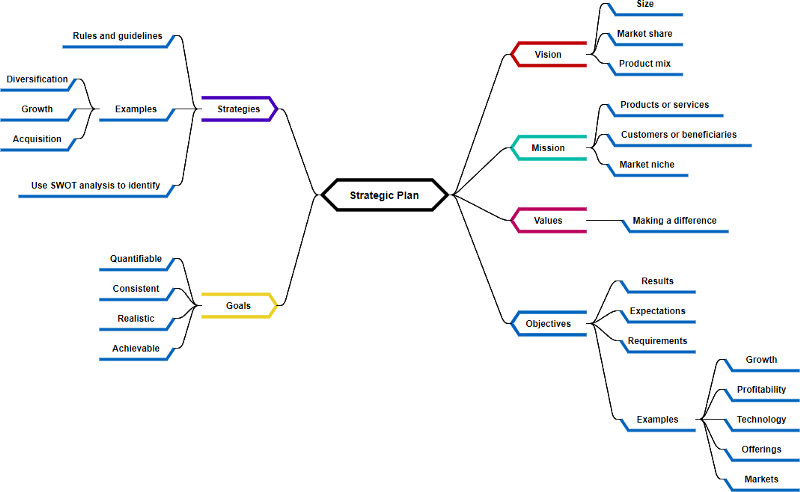
Business Model Canvas
Business Model Canvas offers a simple solution to help businesses discover new business models, and adjust to changes based on the latest conditions. It also Helps Companies to align the resources by fore-seeing the potential trade-offs. Business model canvas is perfect in today’s fast-paced, ever-changing business environment and thus, it is a popular business planning and strategizing tool used by start-ups.
Business Model Canvas at a Glance
The following nine elements make up the boxes of The Business Model Canvas, and each element comes with instructions and questions to consider before filling in that box. They run from who the partners in the project are to what resources are available to what cost and revenue can be expected.
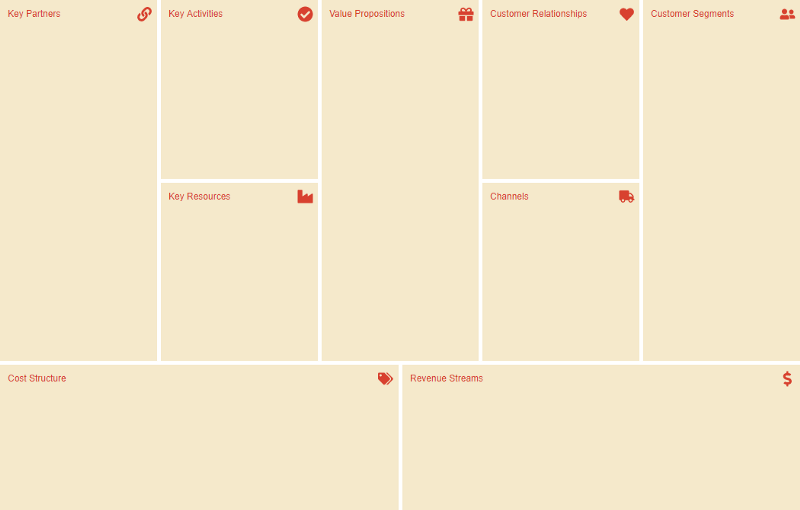
Edit this Business Model Canvas
Business model canvas also helps companies take ideas from the brainstorming stage to lean thinking by focusing attention on the connections between value, customers, and cost, the team can see how their products and services, distribution, costs, and revenue adding value to their customers, thus identifying competitive advantage.
5 Whys
Another tool that’s often used outside of brainstorming, the Five Whys can also be effective for getting thought processes moving forward. When there are issues such as unsatisfied customers, decreasing market share, poor quality, etc. you have to understand the root cause of the issue. Only by addressing the root cause can a problem be fixed. Root Cause Analysis (RCA) is a method of problem-solving used for identifying the root causes of faults or problems. It is widely used in a wide variety of industries.
Simply start with a problem you’re addressing and ask “why is this happening?” Once you have some answers, ask “why does this happen?” Continue the process five times (or more), digging deeper each time until you’ve come to the root of the issue. Dig into the details of the problem.
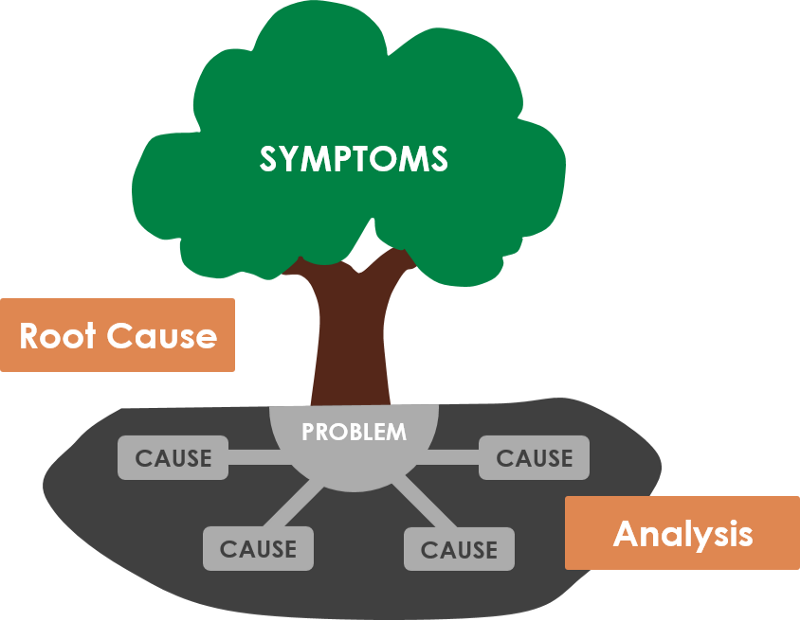
Performing Root Cause Analysis with Multiple 5 Whys using Tree Diagram
Not like a single 5 whys analysis hand one cause at a time, the tree diagram can be used to narrow down and eliminate possible causes in a diagram, ideally to one or more addressable root causes to be considered at one single diagram.
5 Whys Template — with Multiple Causes
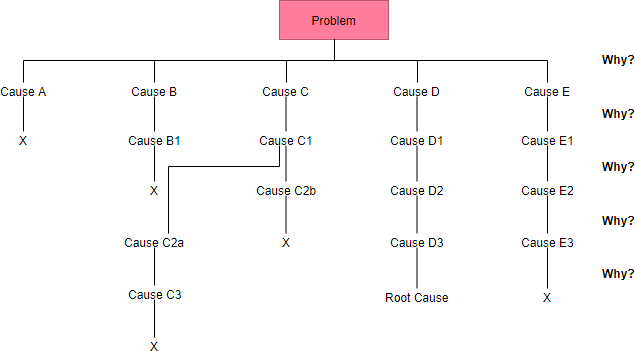
5 Whys Example — Problem in Supervision Visits
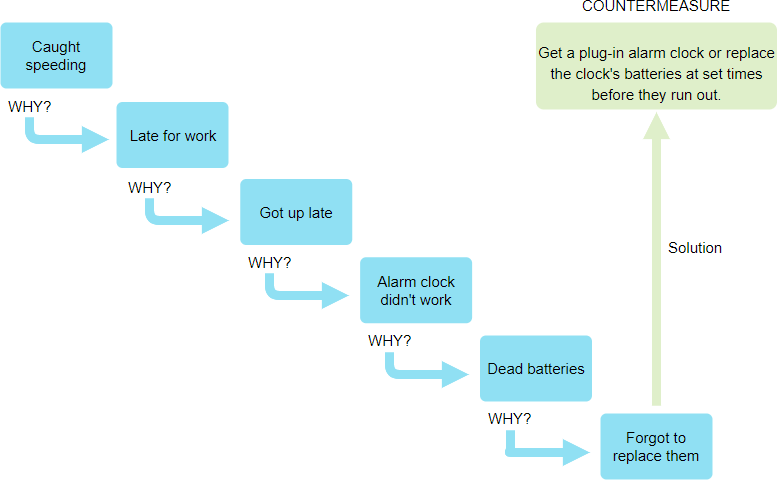
Six Thinking Hat
Six Thinking Hats is a system designed by Edward de Bono which describes a tool for group discussion and individual thinking involving six colored hats. “Six Thinking Hats” and the associated idea parallel thinking to provide a means for groups to brainstorming the parallel thinking processes in a detailed and cohesive way, and in doing so to think together more effectively.
You ‘put on’ or ‘take off’ one of these hats to indicate the type of thinking being used. A ‘thinking hat’ is a metaphor for a certain way of thinking. By mentally wearing different thinking hats people are forced to look at a problem from different perspectives. Thus a one-sided way of thinking is excluded and new insights are created. The key concept for using Six Thinking Hats are as follows:
- Facilitate Parallel Thinking
- Inspire Full-Spectrum Thinking
- Detached Ego Thinking
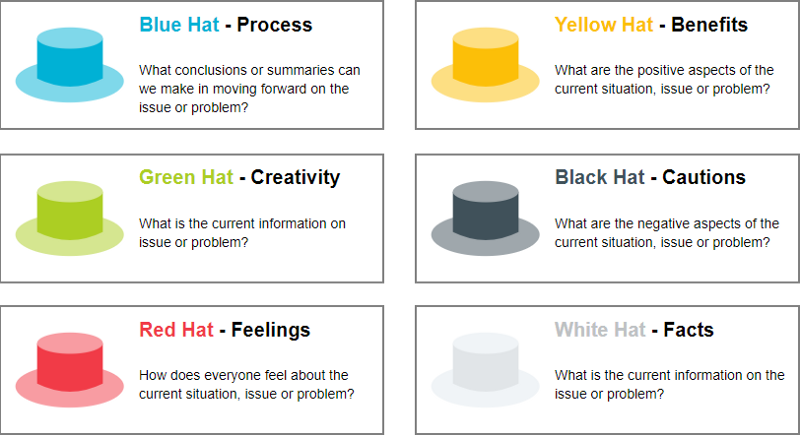
Edit this Six Thinking Hats template
Six Thinking Hat Template
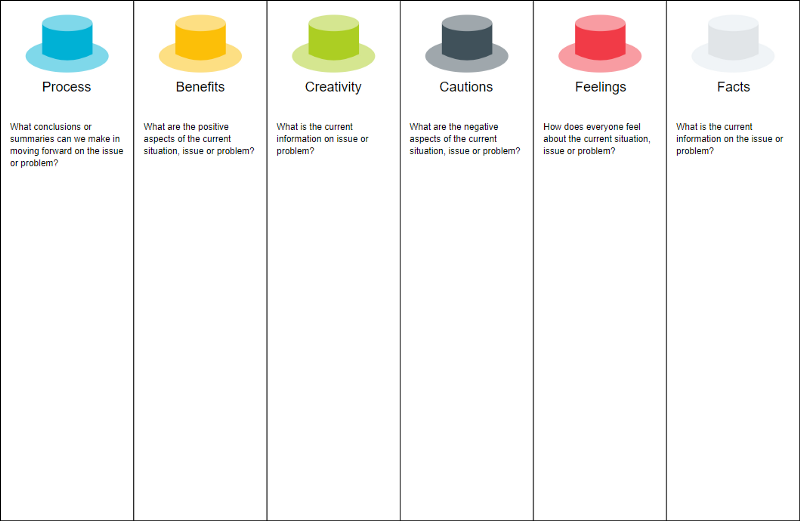
Edit this Six Thinking Hats template
Round-Robin Brainstorming
Round-Robin Brainstorming is a technique for generating and developing ideas in a group. It has the distinct advantage of encouraging contributions from all participants, including those who typically remain silent. It ensures every participant a space to present their ideas without undue influence by potentially overly-assertive or vocal individuals.
How to Conduct a Round-Robin Brainstorming Session
Teams form a circle to kick off this method. The basic structure of a Round-robin session begins with a central theme, question, or issue which the facilitator identifies for discussion. Once the topic is shared, go around the circle one-by-one and have each person offer an idea until everyone has had a turn.
Simultaneously, a facilitator records all ideas so they can be discussed once the sharing is over. It’s very important to not evaluate any ideas until everyone has the opportunity to share.
Just make sure to treat each idea with equal weight and try to discourage people from saying “someone else has already mentioned my idea.”
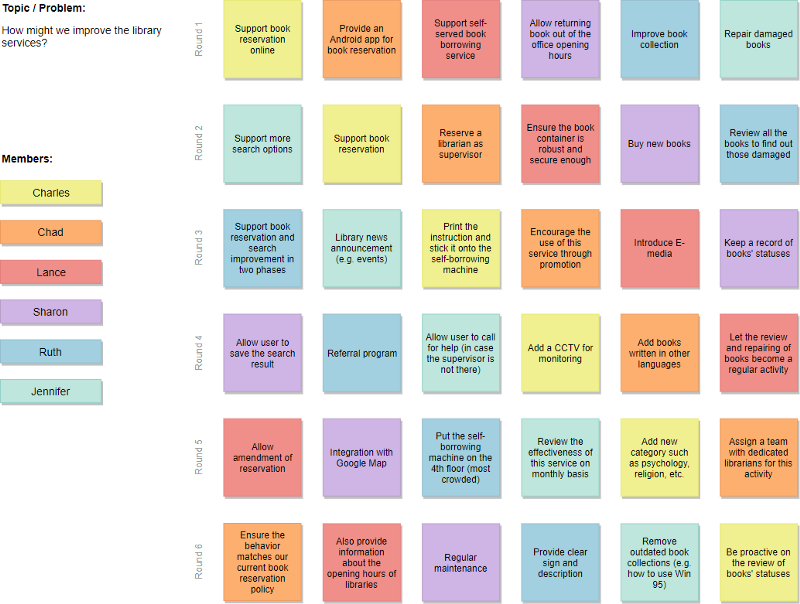
Edit this Round-Robin brainstorming example
SWOT Analysis
Brainstorming is a group creativity technique by which efforts are made to find a conclusion for a specific problem by gathering a list of ideas spontaneously contributed by its members.
SWOT (also known as a SWOT matrix) analysis is a framework that identifies the most important strengths, weaknesses, opportunities, and threats that impact an organization’s challenge or issue that needs to be resolved. The term was popularized by Alex Faickney Osborn in the 1953 book Applied Imagination. SWOT-analysis helps teams to think more freely and they generate as many spontaneous new ideas as possible.
The 4 Parameters of SWOT Matrix
Strengths and weaknesses are frequently internally-related, while opportunities and threats commonly focus on the external environment. The name is an acronym for the four parameters the technique examines:
- Strengths: Characteristics Of The Business Or Project That Give It An Advantage Over Others.
- Weaknesses: Characteristics Of The Business That Place The Business Or Project At A Disadvantage Relative To Others.
- Opportunities: Elements In The Environment That The Business Or Project Could Exploit To Its Advantage.
- Threats: Elements In The Environment That Could Cause Trouble For The Business Or Project.
SWOT Template
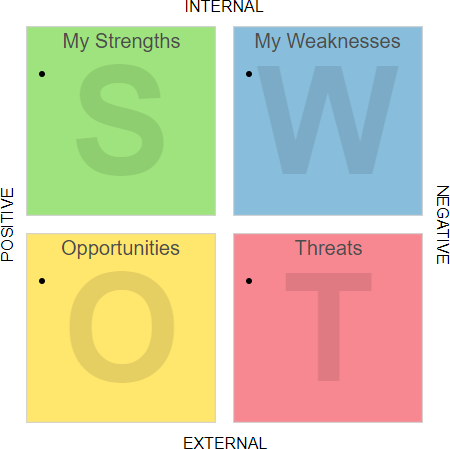
SWOT Analysis Example
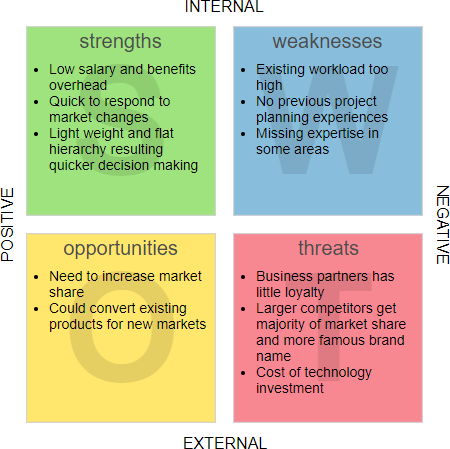
Edit this SWOT Analysis example
Star bursting
Star bursting helps you identify key questions that need to be answered. It’s a brainstorming technique that focuses on generating questions rather than answers. It involves drawing a six-pointed star with the idea with the terms ‘What’, ‘Why’, ‘Who’, ‘Where’, ‘When’, and ‘How’ on each point of the star.
How to Create a Starbursting?
Create a six-pointed star. At the center of the star, write the challenge or opportunity you’re facing. At Generate questions for each point of the star: who, what, where, when, why, and how, i.e., Who are our happiest clients? What do our clients say they want?
For example, your partner came up with an idea of a new product.
- One Question You Might Ask Me “What’s The Target Market?”
- Answer: Boys Of 14–18 Age. But This Isn’t Enough To Describe The Target Audience Of Your Product.
- To Get More Clarity Of The Customer, You Need To Ask:
- What Are Their Interests?
- Why Did You Choose Them?
This not only gives you more clarity of the product but also helps your partner to think through other perspectives too.
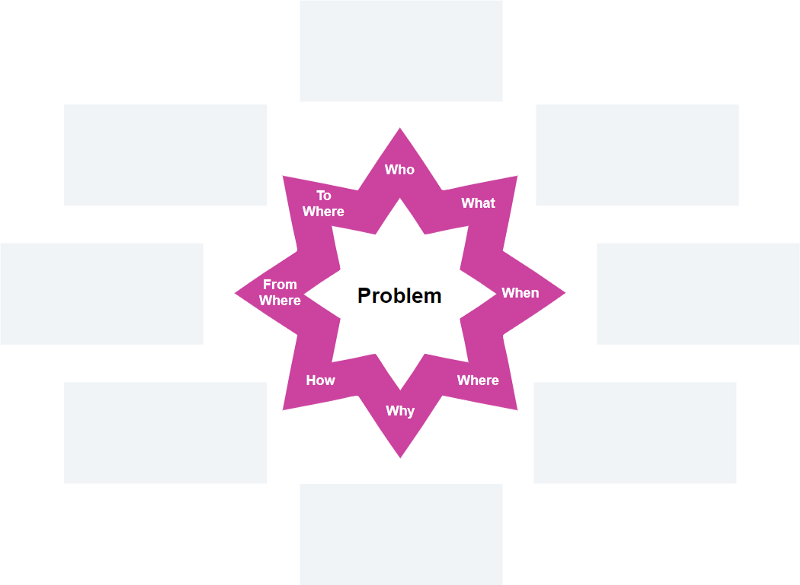
Edit this Starbursting template
Strabursting Example — Mobile Application
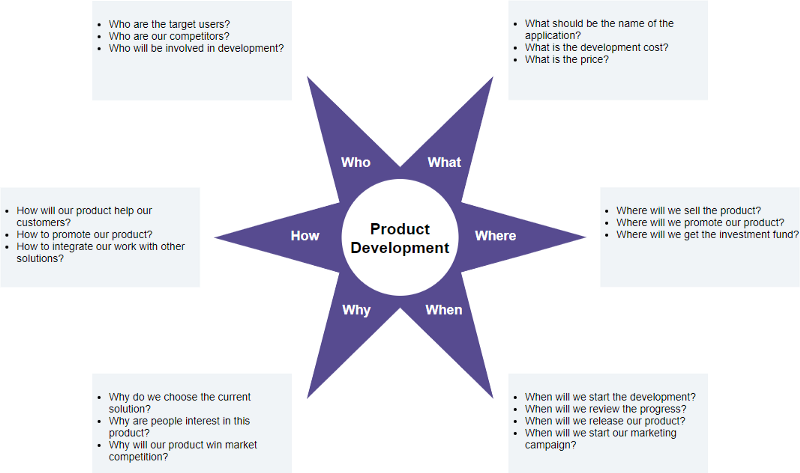
Edit this Starbursting example
Affinity Diagram
Affinity diagrams aren’t focused specifically on helping groups generate ideas, but they provide a way to help organize your ideas after a brainstorming session is done. Created in the 1960s by Jiro Kawakita, It helps large numbers of ideas to be sorted into groups for review and analysis. These, simple to produce, diagrams are particularly useful with a large group where ideas that are generated at a fast pace require to be organized.
Affinity Diagram Example — Schedule Issues
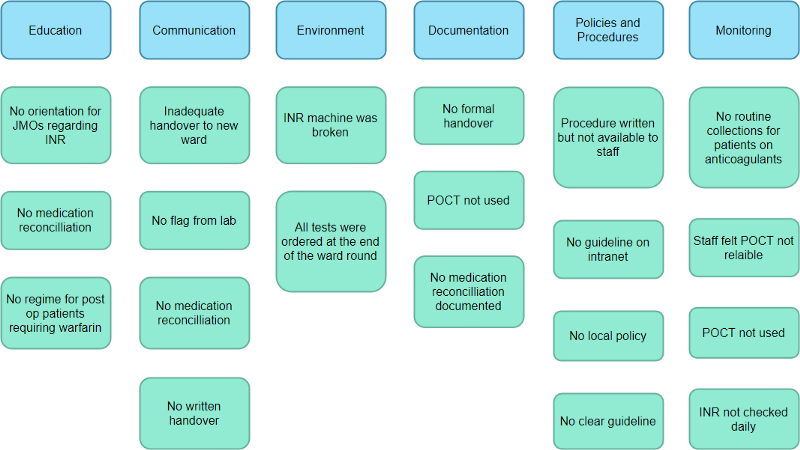
Edit this affinity diagram example
Lotus Diagram
The Lotus Blossom Technique is a structured brainstorming exercise used to expand on a central idea or problem. A Lotus Blossom map, developed by Yasuo Matsumura, can help us to brainstorm and think about a much broader collection of ideas and potential solutions to our challenges. It does so through the use of a visual representation of ideas and is similar to a mind-map, but is more structured and pushes you in ways you don’t experience in classic mind-mapping.
What is Lotus Blossom Chart?
Teams place the original problem statement in the center box in a 3×3 matrix, then add related themes or elements of the problem in the 8 boxes surrounding it. The following diagram visually shows how the Lotus Diagram is laid out:
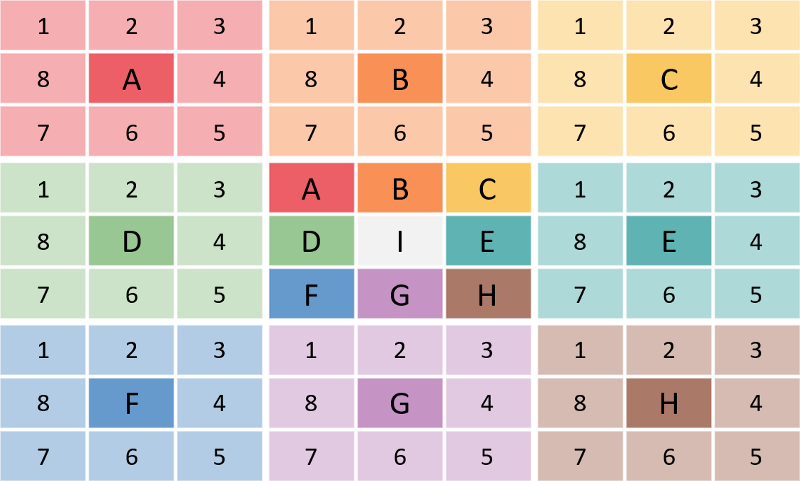
Lotus Blossom vs Mind Map
Similar to mind maps, the Lotus Blossom brainstorming technique lets you dig deeper into and explore ideas related to your problem or challenge, in much the same way that a mind map empowers you to dig deeper and deeper into it, with successive levels of topics, sub-topics, and sub-sub-topics.
Brain Writing
Brainwriting is a brainstorming method to generate new ideas. The method was developed Bernd Rohrbach in 1968 and was originally named as 6–3–5 brainwriting or 635-method or method 635 as it involved:
- 6 Participants Are Supervised By A Moderator
- They Are Asked Down To Write 3 Ideas Based On A Specific Problem
- Within 5 Minutes On A Blank Worksheet.
The team swaps the list they made with the next team sitting at their right and as soon as 6 rounds are over, there will be a total of 108 ideas generated in 30 minutes. What this particular technique proves is that within a short period, a wide variety of numerous ideas can be generated.
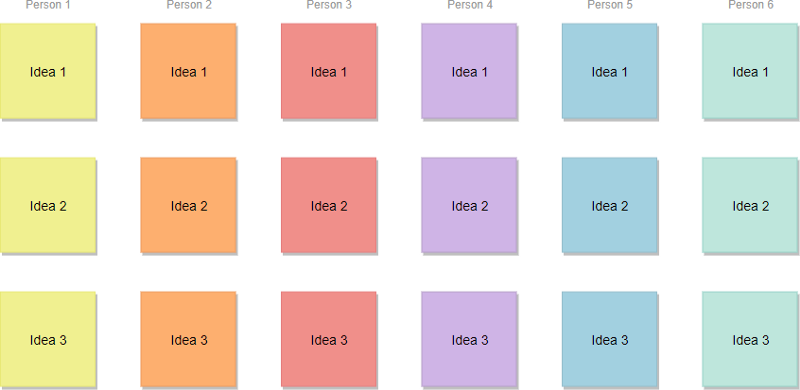
Edit this Brainwriting template
The big advantage of brain-writing is that it makes sure everybody is allowed to have their thoughts and ideas thoroughly considered by the group. This avoids the loudest or most extroverted people unintentionally dominating the sessions.
Stepladder brainstorming
Stepladder brainstorming is a technique for improving the quality of group decision that minimizes the tendency for group members to be unwilling to present their ideas by adding a new member to a group one at a time and required each to present his or her ideas independently to a group that already discussed the problem at hand.
So, with step ladder brainstorming, everyone makes contributions without being influenced by the whole team. The rule is to leave two members in the room together with the team leader. They can’t stop discussing topics until the third one added. The new person is asked to share his ideas before discussing the ideas generated by the first two people. Keep repeating this routine until everyone is together in the room.
What makes this method different is that this technique allows the newest member of the group to present their ideas and solution first. This method encourages everyone to give their part before being influenced by any outsiders. What happens from this is an explosion of ideas. The Stepladder Technique is illustrated as follows:
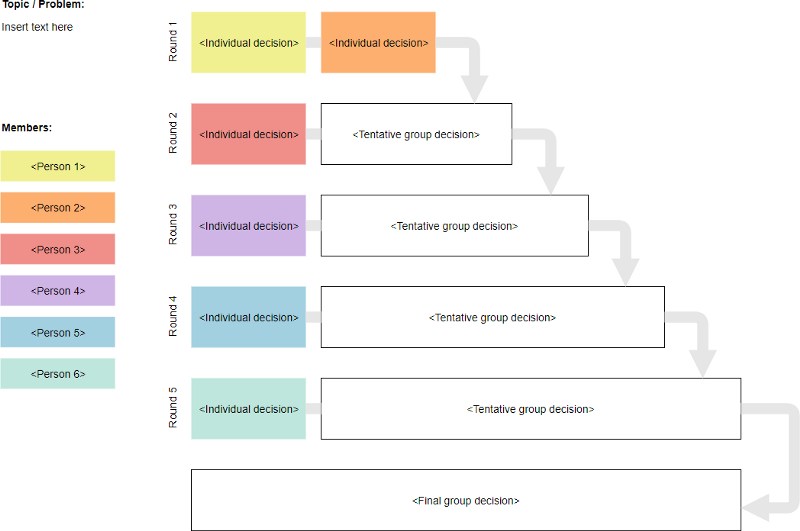
Edit this Stepladder brainstorming template
Reverse Brainstorming
Reverse brainstorming empowers companies to solve problems through a creative brainstorming approach. It is a technique that flips typical brainstorming practices upside down, allowing you to approach complex problems from a different perspective. Instead of asking how to solve the problem, reverse brainstorming focuses on the idea of what causes the problem or how to achieve the opposite result of what is expected. Identifying the problem and how the problem can be worsened can help the team to understand the best solution. For example, the team thinks about how to increase the cost instead of how to reduce it.
This creative brainstorming approach asks:
- Would it work?
- Why or why not?
- Does the “usual” approach work well, or are there better options?
- What would someone else do in our situation? Then imagine doing the opposite.
In the reversed brainstorming, the group members move between five main stages as following:
- Problem — In this stage, the team defines the problem that needs to be solved through the final product or service.
- Reverse — The team reverses its mindset. So, they think about how to make the problem worse.
- Collect — The team starts brainstorming ideas that can make the problem worse and discuss it with this approach in mind.
- Reverse — The ideas are reversed to form solutions or suggest solutions for the problem.
- Evaluate — The team evaluates the different solutions and see if it works as a solution for the original problem. Note that, the main idea of this stage is to check if the ideas provide solutions for the problem after reversing it.
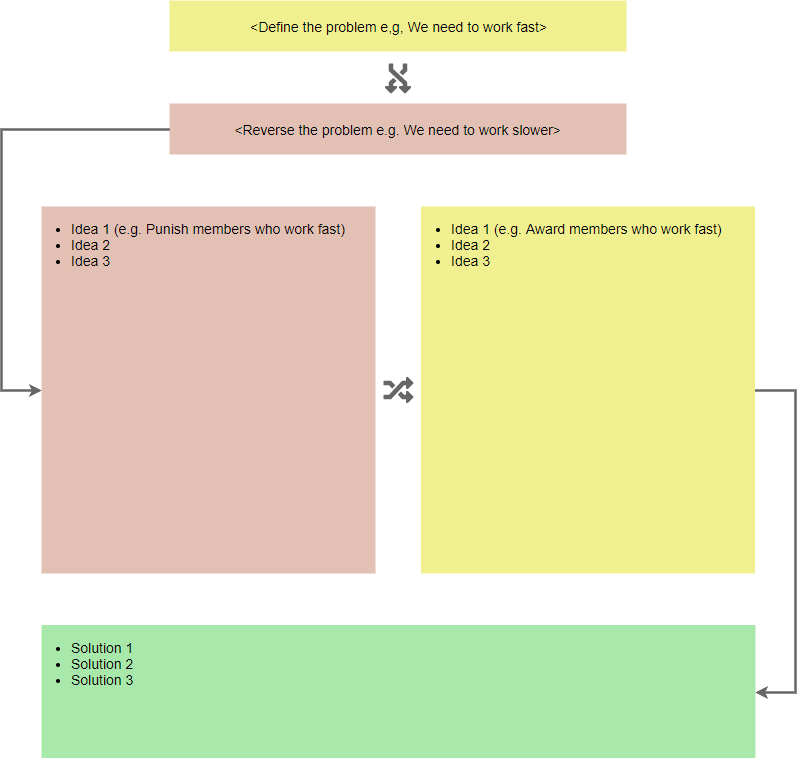
Edit this reverse brainstorming template
Empathy Map: Say — Think — Feel — Do Model
An empathy map, created by Dave Gray, is a collaborative tool team can use to gain a deeper insight into their customers. It gains popularity in the agile community for understanding the context, psychological and emotional needs of customers.
Much like a user persona, an empathy map can represent a group of users, such as a customer segment that helps us to make better product design-oriented decisions by prioritizing the user’s needs. It is widely used as the foundation of the UX process and hints on what further steps are needed in UX research to create the full-fledged user-persona.
What is a Say — Think — Feel — Do Model?
If you’ve never come across an empathy map before, they provide in-depth context about what a user is saying, thinking, feeling and doing whilst accessing a service, while means that an empathy map (Say — Think — Do — Feel model) is split into 4 quadrants, with the user or persona in the middle as shown in the following figure:
- Says — It Generally Highlights The Problem Set And Focuses Upon What Exactly A User Is Looking For.
- Thinks — “It Concludes What The User Is Thinking All The Time While Performing Different Actions In Their Journey.
- Does — It Is Used To Jot Down The Observed User Behavior While They Were Performing A Set Of Different Actions.
- Feels — It Collects The General Human Emotions Like Frustration Or Delight Whichsoever Is Experienced By The Interviewee.
- Pain — It Describes What Their Biggest Frustrations Are, What Obstacles Stand In Their Way And Which Risks Might They Fear To Take?
- Gain — It Describes What Do They Need To Achieve And How Do They Measure Success?
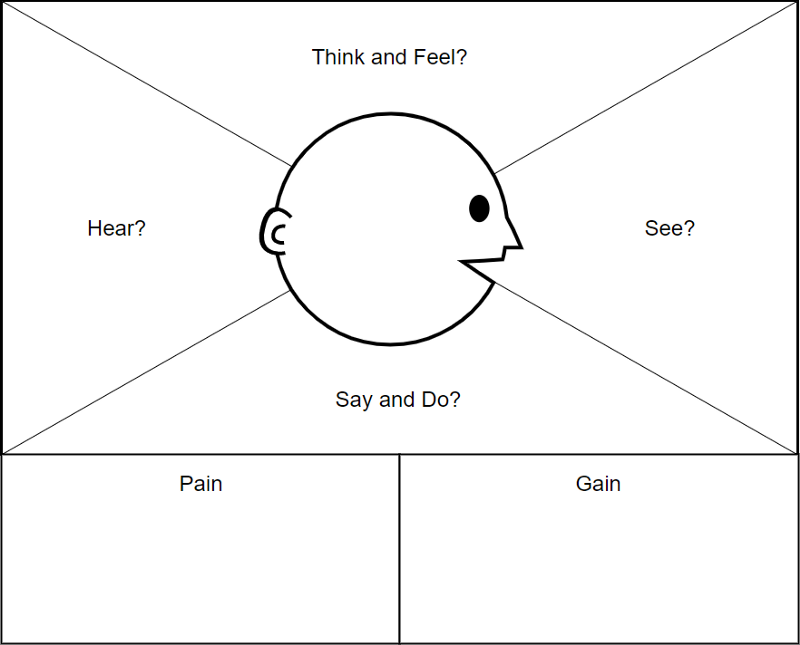
Edit this Empathy map template
Empathy Map Example — Student Live
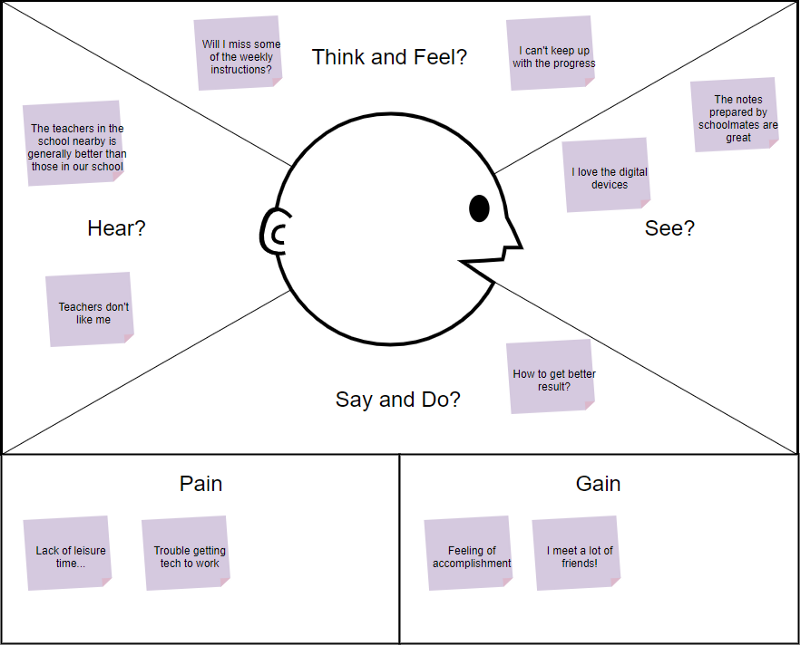
General Tools for Brainstorming
How do you quickly capture these brainstorming ideas while creating a record that you can analyze, edit, and act on later? We can use some general diagramming tools, process matrix, ideation board, and infographic creatively for brainstorming, presenting, planning or managing new ideas as well. This visual representation can help you quickly recognize and structure and hierarchies, making it a snap to pull a plan of action out of a chaotic idea-generating session.
Concept fan
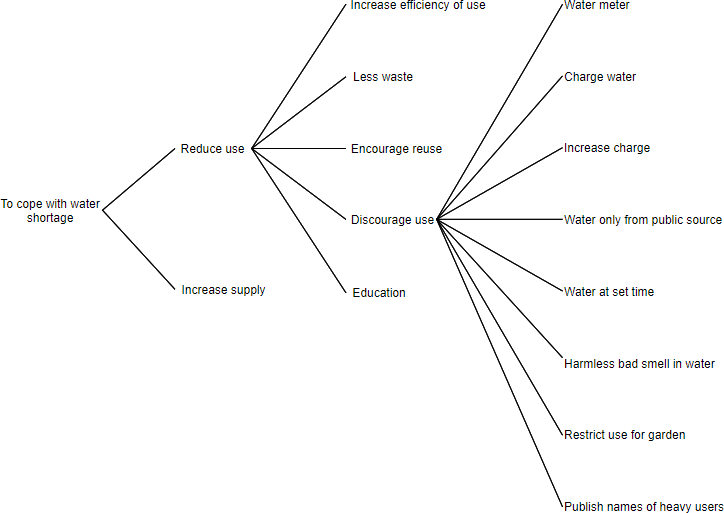
Concept map diagram
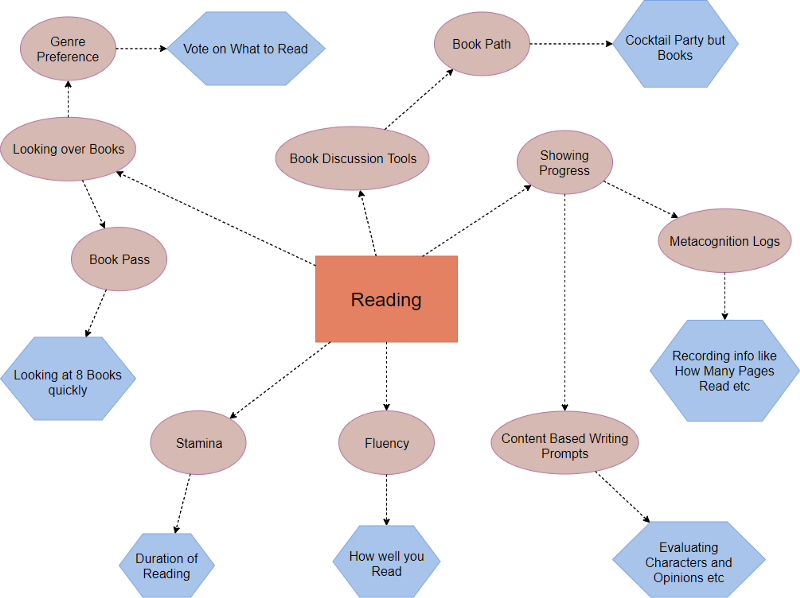
Edit this concept map diagram example
Bubble diagram
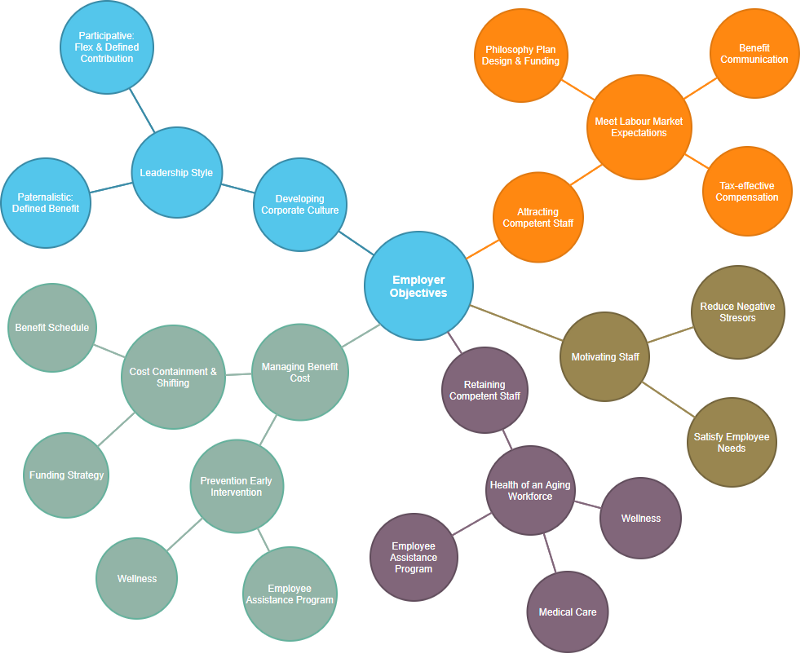
Edit this bubble diagram example
Cluster diagram
This post is also available in Deutsch, Español, فارسی, Français, Bahasa Indonesia, 日本語, Polski, Portuguese, Ру́сский, Việt Nam, 简体中文 and 繁體中文.













